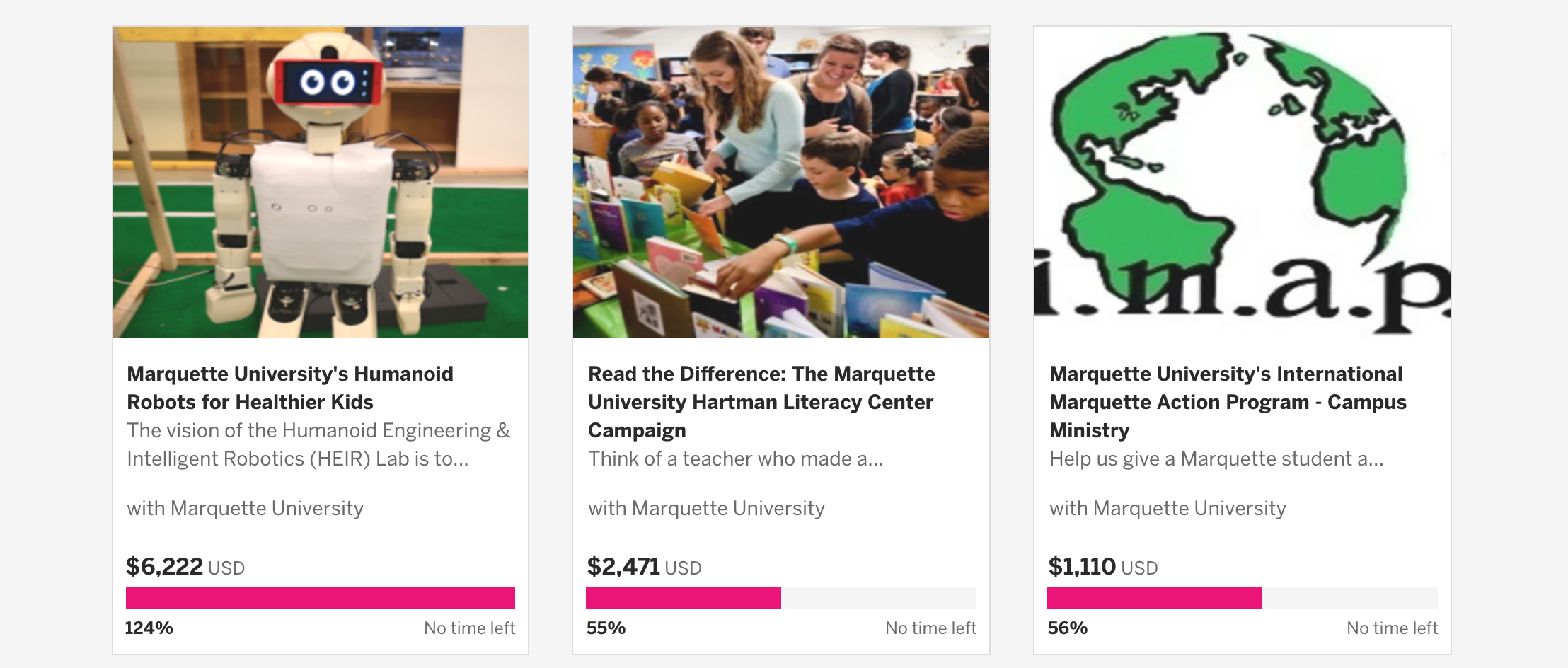Today we’re publishing a really smart Q&A with our associate metrics editor, Tim Cigelske, on a classroom project he developed to teach students metrics. A version of this article ran on the CASE Currents blog.
Tim Cigelske, social media director at Marquette University and MediaShift associate metrics editor, teaches a social media analytics class to undergraduates from across the school. Starting in 2013, he developed an innovative class project to get students hands-on experience while showing them how social media metrics are tied to real-world impact.
The project? A crowdfunding competition.
Each team of students was assigned an on-campaign crowdfunding campaign. They then tracked their campaign performance based on intermediate metrics that led to a real world outcome, such as raising money for service trips or building soccer-playing robots. The crowdfunding dollars were a tangible metric to show that analytics are more than likes and comments, and can translate into something real.
Here he shares his ideas about the value of the class in teaching metrics and his approach to hands-on teaching.
Q&A
What were you trying to learn specifically on a personal (or professional) level as you worked on this project?
Three words: return on investment. Social media can’t just be reduced to a bottom line, but I do think social media managers need to show value in terms of dollars and cents. What better place to explore this topic than a class on social media measurement? My approach to the classroom is to treat it like a laboratory. We don’t have all the answers, but we’ll try things together and analyze the results. I’m also figuring it out as I go along by crowdfunding the textbook I wrote for this class. In the process, we’re helping departments across campus with social media and fundraising, measuring ROI and giving students some real-world experience for their resume. It’s a win-win-win.
How is the crowdfunding project structured within your class? Do students vote on one project or are there several? What are their roles?
My colleagues in the university advancement department helped me identify Marquette projects that would be good candidates for crowdfunding. After surveying and vetting each one, we narrowed them down to seven projects for my social media analytics and measurement class to work on throughout the semester.
I had student teams interview with a representative from each project, whom we called a client, just like it was a job interview. They interviewed at our Career Services Center and combined it with a presentation on interview etiquette, tips and best practices. I wanted to give the students (most of whom are seniors) some real-world interview experience and get client feedback for the best match.
Then I put the teams and clients together and they got to work.
What types of causes or projects did you choose?
It varied. We have on-campus projects for service trips, autism research, literacy programs, a humanoid robot and international student housing. There is one project with the American Cancer Society that supports Relay for Life, an external community project that works very closely with student organizers and participants. They are all listed on IndieGoGo’s partner page (with the exception of the American Cancer Society project, which has its own platform).
What's #crowdfunding? Learn how our students are using @Indiegogo for real-world projects: http://t.co/97knTQMZZe pic.twitter.com/UnTtZxy7hy
— Diederich College (@MUCollegeofComm) March 31, 2014
Is there a digital identity angle to this class—for example, do you provide lessons on developing a professional social identity as they promote the cause?
Absolutely. For the first half of the semester, students create a social media strategy for their client and document it all through an online portfolio on Tumblr. Their first assignment was to write a bio of their team and explain why a potential client should hire them. The model for this, as cited in the syllabus, was the idea that blogging is the new resume. I don’t just want them handing in Microsoft Word papers to me. I want their work to be searchable and available to potential employers online, which also makes students more accountable.
Does the project live on after the semester or is it more of a “crowdfunding blitz,” where they have to raise the money within a week or two?
The actual crowdfunding campaign was live for a full month, but the larger strategy is creating a foundation for analyzing and measuring each department’s social media. The process is about identifying mission, audience, platforms and other components for using social media successfully. Each department’s social presence should keep growing after this class. The crowdfunding component is just a way to get it “kickstarted.”
How did it go? What did students learn about social media and crowdfunding by looking at the metrics during their campaigns?
I think there were lessons for both students and myself as an instructor. Some students asked for more structure or said that their group projects for the full semester could become “tedious.” I wanted them to struggle through some of those issues, but also took the feedback to heart to meet students where they were in future semesters. The most positive feedback about the format came from the fact that working with metrics produced real-world impact. Here’s one end-of-semester evaluation: “I thought that this was an amazing class. We got to work with a real client throughout the semester and were able to raise over $5,000. This class and project is something that I continuously bring up in interviews and it has helped to set me apart from other candidates. It was one of the most beneficial classes that I have take at Marquette and I loved that it was real life instead of hypothetical. We were actually able to make a difference and that is FABULOUS.”
Jennifer Doak-Mathewson is Director of Engagement & Acquisition at the UConn Foundation and a freelance editor. She was previously an online communications specialist at the Council for Advancement & Support of Education.

